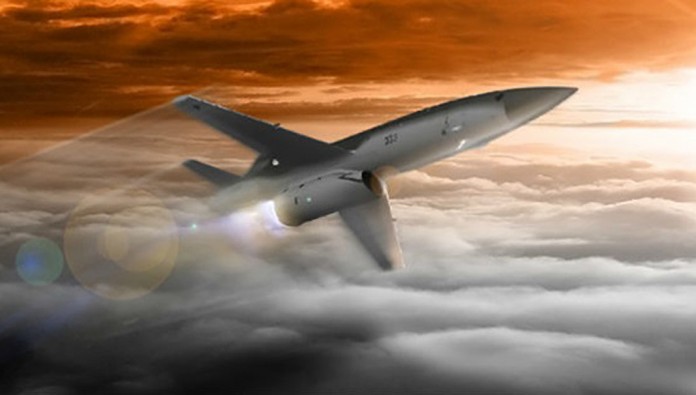
Kratos Defense & Security Solutions, Inc. announced this week the completion of a second test flight of a jet-powered unmanned aerial combat vehicle (UCAV) on November 23, 2015. the flight that took place on the US Navy test range at China Lake, CA involved a newly developed jet-powered drone developed by Kratos, and a US Navy/Marine Corps AV-8B Harrier manned jet fighter. A month later, on December 11, 2015, the third demonstration flight featured two UTAP-22 aircraft flying in continuous collaborative airborne operations through the tactical datalink, while flying formation with one another, flying formation with a third UTAP (simulated) as the lead aircraft.
The flight consisted of collaborative airborne operations with a US Marine Corps AV-8B Harrier. The flight evaluated command and control through the tactical data link; execution of semi-autonomous tasks; execution of autonomous flight in formation with the AV-8B; transfer of UTAP-22 control between non-line-of-sight (over the horizon) operators in the tactical network; and transfer of control (handoff) from the tactical network to an independent dedicated control link. The two-unmanned formation test successfully coordinated semi-autonomous payload deployment, breaking formation to perform independently with a subsequent rejoin, and loyal/trusted wingman flight with one UTAP being flown as if it were a manned aircraft and the second UTAP-22 joining and sustaining autonomous formation. Throughout the mission multiple UTAP-22 were controlled by a single operator.
The UTAP-22 is based on the company’s BQM-167A, a subsonic aerial target designed to perform threat simulation of a high-performance threat aircraft and/or threat missiles. The BQM-167 has a speed in excess of 0.91 Mach and can operate at altitudes from 40 feet to more than 50,000 feet. The turbojet-powered UTAP-22 is 20 feet long with a wingspan of 10.5 feet. It is launched from a ground site using a rocket-assisted takeoff booster and is recovered after parachuting in the water or on land. Changes from the BQM-167A include some airframe modifications, a mission computer, a data link and a command-and-control system.
[ismember]The UTAP-22 Tactical UAS is a high performance jet aircraft designed specifically to carry and deliver tactical payloads in contested, hostile environments. US services and the Central Intelligence Agency are flying combat missions using unmanned aircraft – or drones – designed for operations in uncontested airspace, meaning in battle zones where enemy air defense is minimal or non existent. But with the proliferation of air defense systems and the need to operate drones in contested airspace, such as the situation in East Asia, North Korea, Eastern Europe or Syria, services will require faster, more agile and stealthier drones that will be able to operate and survive in denied and contested airspace.
A potential tactical scenario is one in which a manned aircraft, with a back-seater using a tablet, controls numerous UTAP-22s to overwhelm enemy defenses. Potential missions include strike and electronic attack.
Such drones could take off from the ground or aircraft carriers like conventional aircraft, or be launched from combat aircraft or ‘motherships’, extending the combat endurance of today’s fighters, along with increased lethality and stand-off attack capability. In fact, by avoiding direct confrontation with the enemy, conventional aircraft to remain relevant and valid for many years, in conducting counter-air or close-air-support (CAS) operations, without the need for excessively expensive upgrading employing manned-unmanned teaming with smaller, faster and more agile stealthy drones, that will be able to operate for hours in contested airspace.[/ismember]
UTAP-22, (unmanned tactical aerial platform) was developed by Kratos as a privately funded initiative. The recent flight was the second in the currently planned three-flight series of the unmanned aircraft. According to Kratos executives who attended the demonstration, the demonstration validates the ability of low-cost, unmanned aircraft with fighter-like-performance, to operate collaboratively with tactical manned aircraft through semi-autonomous tasking and autonomous formation/wingman modes.
The UTAP-22 “is ready for weapons integration and demonstration to the fleet,” said retired Rear Adm. Dennis FitzPatrick, vice president for Tactical Platforms Operations in the Unmanned Systems Division of CEi.
“I firmly believe our UTAP-22 concept of a tactical manned aircraft teamed with unmanned aircraft capable of operating at tactical speeds, in a hostile environment, will be an affordable, effective and valuable tool for the warfighter, addressing a critical need.” Jerry Beaman, President, Kratos’ Unmanned Systems Division commented.
According to Beaman, the new concept provides the warfighter with new capabilities as a front line force multiplier. “This successful mission, our first test of manned/unmanned operations was a major step forward in our unmanned tactical aerial system strategy and roadmap.” Beaman maintained saying “Kratos UTAP-22 is the most important unmanned aerial system initiative that our Company is pursuing as related to the unmanned tactical aerial vehicle market.” He added that additional flights, demonstrating simultaneous UTAP-22 operations are planned for the near future.
[nonmember]This is an abstract of the 792 word article available to Defense-Update Members. Join now to subscribe[/nonmember]



















